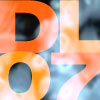Shaun Wilson, Uber Nocturnus iii (2007), HDV , 9 mins
Saturday, February 9th--Tonight the real meat and bones of experimental short films were out in full force. The traditional narrative was no where to be found and the idea of film itself was taken for quite a philosophical ride by a variety of film makers from Australia and beyond. Shaun Wilson, whose name reminds me of the Factory records impressario Tony Wilson in it's seeming innocuousness compared to such a controversial personality, curated a set of Australian films that touched on his favorite subject matters--destruction, mystery, horror, the undead, and pornography. These films relied on odd juxtapositions, spooky lighting filters, and eerie music. 
Tammy Honey, 9 Cinemas (2008), HDV as single channel projection, DVD, colour, sound, 5 mins
Shaun Wilson's wife Tammy Honey provided the most unique vision in this series of films. The film called 9 Cinemas opened with a screen filled with nine boxes reminiscent of the opening credits for the uber drippy and inexplicably popular American tv series, The Brady Bunch. Instead of a Brady in each box, however, they were filled with scantilly clad women in various states of undress and arousal. The continuous soundtrack throughout the film was filled with the sighs, moans and heavy breathing we've come to associate with pornography. Slowly the differences between 'popular pornography' and this particular instantiation become more clear. These women are shaking their bodies far more vigorously than one would expect from a seasoned porn queen. Their breasts and stomachs and thighs bounce and jiggle with a spastic motion that seems only slightly out of place for the genre. Secondly, the costumes are close to the usual porn-fare but slightly off somehow. One actress has on construction worker's safety headphones, another wears a Rambo commando outfit complete with gun, still another wears a navy blue farmer-girl turned grunge goddess buttondown, her hair in pigtails. Somehow all of these costumes are a bit complicated visually. Typical pornography is so direct in its motivations and its presentation that the viewer does not need to think about what he or she needs to think about while they are watching. Tammy Honey's honies, on the other hand, provoked the slightest question mark. Or maybe it was the setting--an art film festival--that problematized the viewers relationship to the actresses onscreen. Every so often a woman would be shown shoulders up, in one of the saucy costumes, just staring at the viewer questioningly. I can't even be sure it was the same woman every time, although I seem to remember this. There were 9 screens afterall so it's hard to keep track. But this woman seemed to be staring at the viewer so directly that if you happened to be looking back at her, it was uncomfortable. Was that Tammy Honey, I wondered? It was over before I could form any solid guesses. The sighs and heavy breathing just gone and the room, like all rooms where pornography has taken place, was eerily silent.
The second curator Saturday evening, Daniela Butsch, showed a series of minimal films (compiled by Barbara Hindahl (pK) ) under the heading Minimale Veraenderung. These films were certainly all minimal but they had very different approaches to minimalism. Some were more contemplative including Butsch's own piece Speed Manipulations where she shot the jet propelled current of ocean water at different speeds changing the sound quality and the pattern of the water itself. Martina Wolf had two pieces about the reflections of windows, in the film Fensterbild (13 min, 2001) a window tilted into a room reflects the sterile industrial building outside. Using her hand or a string to pull the window closer and farther away from herself, Wolf creates a dreamlike undulating reflection where the outside and the inside conflate. Perhaps my favorite piece from this series was entitled, The Department of Water and Power, and the film was simply 7 or 8 minutes still shooting a generator during the night. Obviously this is boring. It's the same image and there is no expectation that the image will change while being filmed. It's a power station, they're pretty stable. But it wasn't at all Zen like either as water or a window or a wall might be Zen. No, this was a stare down between the camera and the generator and as soon as I wrapped my head around that, I began to really admire the piece. A still frame shot in real time with real sound, The Department of Water and Power was an experiment in confronting the menacingly banal. The generator whined and hummed continuously, one became aware that the generator would continue to make its generator noise even when the camera was gone. The camera was just doing the difficult work of an investigative journalist with a bad interview--simply observing and trying to push back against the monolith with its own presence. It's certainly a rude staring contest and a thankless job which the camera won't win but for the duration of the film, the audience was just as powerless as the filmmaker and just as exasperated. When the film finally ended, just as suddenly as it had begun, the absence of that awful whining noise was as gratifying as being released from nipple-clamps. Lars Von Trier needs A-list actresses and brutal schedules to create that kind of symbiotic torture with his audience. It's really more minimal and economic to go the route of the power station.
--More Monday, SS



 Spree Getraenke
Spree Getraenke












0 Comments:
Post a Comment